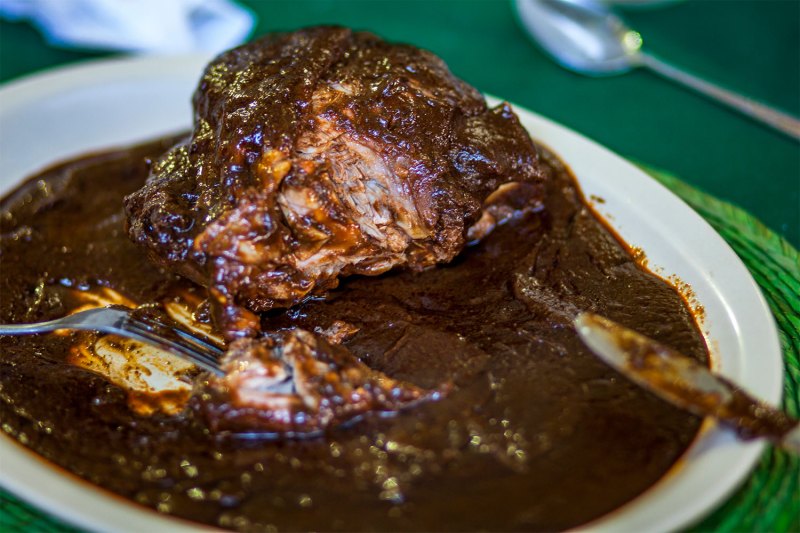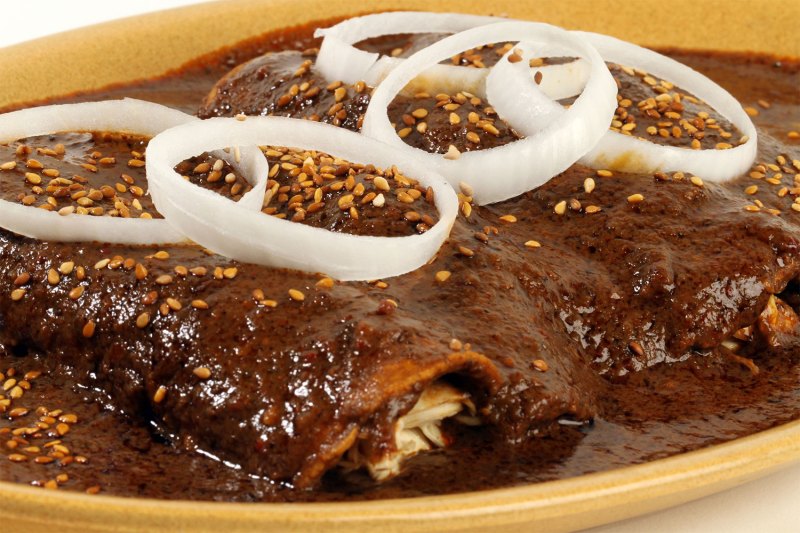In the land of sauces, mole is considered to be the royalty. This infamous Mexican marinade is wonderfully complex, with a host of styles that involve long lists of comforting ingredients. It can be slathered on everything from chicken and pork ribs to mushrooms and tofu. Generally, mole is rich and earthy, with a bit of a kick and spices like chili pepper, cinnamon, and cumin. It’s something of an everything-but-the-kitchen-sink type of sauce that puts a dent in your pantry organization but comes together beautifully.
Related Guides
To this day, two Mexican states compete for the title of mole creator in Oaxaca and Puebla. Like so many great dishes, mole’s impetus is believed to be the ingenuity and resourcefulness of poor folks. A popular genesis story for the sauce takes place at the Covenant of Santa Clara in Puebla where nuns were forced to quickly assemble a dish for a visiting archbishop. A witches’ brew of sorts, the hastily made concoction included chili peppers, nuts, old bread, and some chocolate. They drizzled it over turkey and blew the archbishop’s mind.

Mole touts a fitting name as the word translates from an old indigenous language to “mix.” A simpler version existed before Colonial times and, after, was adapted into something with newfound ingredients like pumpkin, sesame seeds, almonds, and plantains. Chocolate, which feels like a major mole characteristic today, is believed to not have become a focal point until the post-Hispanic era.
There are several kinds of mole and the culinary-minded have been riffing off of these for generations. Mole poblano is arguably the most popular, occasionally even dubbed Mexico’s official national dish. It’s made up of some 20 ingredients, including dried poblano pepper (mulato peppers) and chocolate. Mole negro is the most celebrated to come out of Oaxaca and believed by many to be the most complex. It requires hoja santa, a fragrant herb which translates to “sacred leaf.”
There are many more types, too, each reflecting the regional ingredients of the broad and varied Mexican landscape. Pipian mole, for example, is made of squash seeds informed largely by the Mexico City area. There’s manchamanteles (“tablecloth stainers”), a riff on mole that involves dried chilies, tomatoes, and more. Or mole verde, made green thanks to some combination of green peppers, celery, cilantro, and epazote, just to name a few ingredients. An estimated 300 kinds are known to exist south of the border. Mexican regions battle over its makeup and heritage in the same way Americans do with barbecue (like smoking a brisket).
Because everybody loves a record, the largest batch of mole is reported to have been created at a mole festival in Puebla in 2005. The pot measured more than eight feet in diameter and more than six feet in height, requiring some 1,700 pounds of mole paste and 5,500 pounds of chicken. Oh, to have dived into that sweet and savory nectar of the gods, just once.
Restaurants all over the world create their own unique styles of mole. The permutations are virtually endless because it tends to involve so many ingredients and regional blends. Some of the best pre-made versions are courtesy of Los Angeles institution, Guelaguetza (for the record, LA has more Oaxacan restaurants than anywhere outside of Oaxaca). We suggest the bundle pack, which includes the eatery’s black, red, and Coloradito moles.

Guelaguetza is highly regarded in the realm of mole, having turned out some great ones from its Koreatown restaurant for almost 30 years. It’s now a second-generation outpost known for its lively atmosphere as much as its colorful moles. The restaurant is always worth a visit while in the city of angels but, for the time being, we’ll have to stick with online tutorials and recipes from the eatery.
There are a few other options out there for those who don’t have the time or ingredients to assemble a proper mole. XILLI out of New York has a nice, complex option. You can also get a solid mole brought in straight from Oaxaca via the folks at Zingerman’s. If you are up for whipping up your own, Rick Bayless is a great resources for all things Mexican cuisine. Be sure to have a margarita or two while preparing things.
Many of the best, of course, are painstakingly put together at home or in restaurants. If your favorite Mexican restaurant isn’t doing takeout during quarantine, look out for imported moles at area specialty stores and grocers. And when we’re all traveling and gathering again, check out the largest mole festival in the country.


